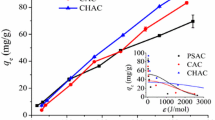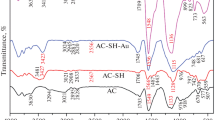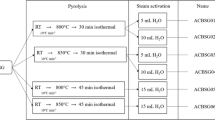Abstract
A high-pressure laboratory elution rig was commissioned to simulate industrial Zadra and AARL elution conditions for the stripping of gold, silver and mercury from loaded activated carbon. It was found that cyanide was essential for the efficient elution of both mercury and silver, while gold was found to elute most effectively in hot, low-ionic strength solutions. Therefore, the standard AARL-type elution, which implements a cyanide soak and water elution, results in a lower recovery of mercury and silver from the carbon. No single set of conditions was found whereby gold, silver and mercury can all be effectively eluted in a single step. However, sequential elution conditions can efficiently recover all metals and provide a potential approach for separating these metals.
Similar content being viewed by others
References
Adams, M. D., and Nicol, M. J., 1986, “The kinetics of the elution of gold from activated carbon”, Gold 100: Proceedings of International Conference on Gol, Vol. 2, C. E. Fivaz and R. P. King, eds., Johannesburg, South Africa, The South African Institute of Mining and Metallurgy.
Brittan, M. I., 1988, “The Bateman AARL carbon elution process,” Proceedings Randol Gold Forum, Golden, Colorado, USA, Randol International Ltd.
Davidson, R. J. and Schmidt, C. G., 1986, “A review of the AARL process for the elution of gold from activated carbon,” Proceedings 13th CMMI Congress, Vol. 4 — Metallurgy, Parkville, Victoria, Australia, Australasian Institute of Mining and Metallurgy.
Holmes, R. J., 2005, “Mineralogical investigation of gold ores,” Advances In Gold Ore Processing, M. D. Adams, ed., Amsterdam, Elsevier.
Marsden, J. O., and House, C. I., 2006, The Chemistry of Gold Extraction, 2nd Edition Littleton, Colorado, Society for Mining, Metallurgy, and Exploration, Inc.
Menne, D. M., 1991, Mercury in Gold Processing, Vol. 1 — Metallurgy, Electromagnetic Books, Mt. Claremont, Western Australia, Australia.
Millard, M., 2005, “Processing of high-silver gold ores,” Advances In Gold Ore Processing, M. D. Adams, ed., Amsterdam, Elsevier.
Smith, E., 1986, “Metallurgy and mineral processing plant at St. Joe’s El Indio mine in Chile”, Minerals Engineering, October, 26–29.
Staunton, W. P., 2005, “Carbon-in-pulp,” Advances In Gold Ore Processing, M. D. Adams, ed., Amsterdam, Elsevier.
Walton, R., 2005, “Zinc cementation,” Advances In Gold Ore Processing, M. D. Adams, ed., Amsterdam, Elsevier.
Zadra, J. B., Engel, A. L., and Heinen, H. J., 1952, “Process for recovering gold and silver from activated carbon by leaching and electrolysis”, U.S. Bureau of Mines Report of Investigations, No. 4843, Washington, DC.
Zárate, G., 1985, “Copper and mercury behaviour in cyanidation of gold and silver minerals,” 15th Annual Hydrometallurgical Meeting, A. J. Oliver, ed., Vancouver, Canada, CIM Metallurgical Society.
Author information
Authors and Affiliations
Additional information
Paper number MMP-09-041.
Discussion of this peer-reviewed and approved paper is invited and must be submitted to SME Publications Dept. prior to May 31, 2011.
Rights and permissions
About this article
Cite this article
Bunney, K., Jeffrey, M.I., Pleysier, R. et al. Selective elution of gold, silver and mercury cyanide from activated carbon. Mining, Metallurgy & Exploration 27, 205–211 (2010). https://doi.org/10.1007/BF03402444
Received:
Accepted:
Published:
Issue Date:
DOI: https://doi.org/10.1007/BF03402444




